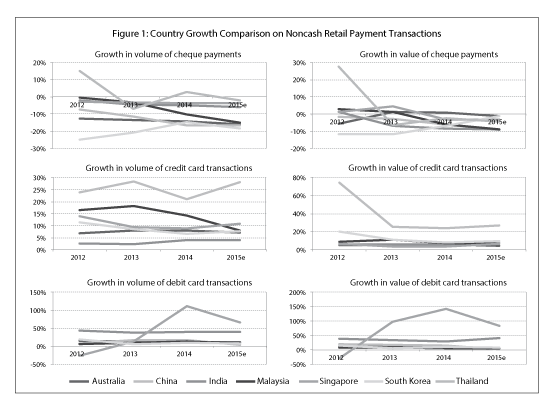New payment options in the market are creating new opportunities, making competition fiercer, and reducing the use of cash and cheques.
February 03, 2016 | Wendy WengTechnological advances are changing the retail payment landscape significantly. Continuous retail payment innovations enable customers to make payments in more diverse ways and are also altering consumer payment behavior. Cash remains to be the most frequently used retail payment instrument, especially for small-value payments, but the use of noncash retail payment instruments is increasing. Transaction cost, transaction speed, convenience, and security are the primary factors affecting decisions of customers and businesses in the selection of payment instruments. The arrival of new payment instruments and nonbanking payment service providers has intensified the competition, which helps to lower transaction cost, enhance efficiency, and reduce risk.
A trend observed in all the seven countries covered in this report was that cheque payments, while remaining an important payment instrument in the near future, have shown a significant downward trend in recent years (Figure 1). Cheques are being used less compared to card payments and other electronic payment methods, which provide convenience as they require no clearing time. On average, the volume of cheques in these seven countries dropped by 9% and the value declined by 5% in 2014, and is expected to decrease further. China, India, and Thailand have seen the largest decline in the share of cheques by value in the past few years. In China, the volume and value of cheque payments went down by 17% and 6%, respectively, in 2014. However, cheques still account for a considerable portion of the value of noncash retail payment transactions, as some customers prefer to use cheques for large-value transactions.

Figure 2 shows that in Australia, Singapore, and Thailand, both credit cards and debit cards are experiencing flat growth in terms of value. In Australia, where alm...
Categories:
Cards, Credit Cards, Mobile Banking, Payments, Retail Banking, Technology & OperationsKeywords:Asia Pacific, Retail Payments, Credit Cards, Debit Cards, Mobile Payments, Cheques, Digital Payment
New payment options in the market are creating new opportunities, making competition fiercer, and reducing the use of cash and cheques.
February 03, 2016 | Wendy WengTechnological advances are changing the retail payment landscape significantly. Continuous retail payment innovations enable customers to make payments in more diverse ways and are also altering consumer payment behavior. Cash remains to be the most frequently used retail payment instrument, especially for small-value payments, but the use of noncash retail payment instruments is increasing. Transaction cost, transaction speed, convenience, and security are the primary factors affecting decisions of customers and businesses in the selection of payment instruments. The arrival of new payment instruments and nonbanking payment service providers has intensified the competition, which helps to lower transaction cost, enhance efficiency, and reduce risk.
A trend observed in all the seven countries covered in this report was that cheque payments, while remaining an important payment instrument in the near future, have shown a significant downward trend in recent years (Figure 1). Cheques are being used less compared to card payments and other electronic payment methods, which provide convenience as they require no clearing time. On average, the volume of cheques in these seven countries dropped by 9% and the value declined by 5% in 2014, and is expected to decrease further. China, India, and Thailand have seen the largest decline in the share of cheques by value in the past few years. In China, the volume and value of cheque payments went down by 17% and 6%, respectively, in 2014. However, cheques still account for a considerable portion of the value of noncash retail payment transactions, as some customers prefer to use cheques for large-value transactions.

Figure 2 shows that in Australia, Singapore, and Thailand, both credit cards and debit cards are experiencing flat growth in terms of value. In Australia, where alm...
Categories:
Cards, Credit Cards, Mobile Banking, Payments, Retail Banking, Technology & OperationsKeywords:Asia Pacific, Retail Payments, Credit Cards, Debit Cards, Mobile Payments, Cheques, Digital Payment

